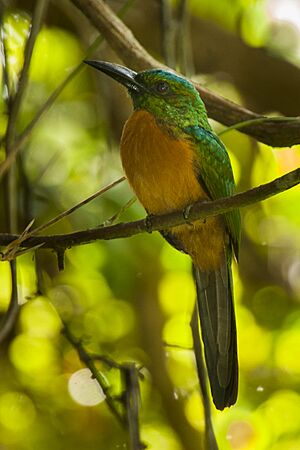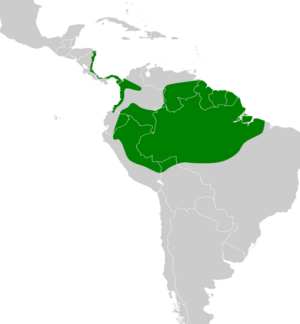Great jacamar facts for kids
The great jacamar (Jacamerops aureus) is a colorful bird found in the warm, wet forests of Central and South America. It lives in countries like Brazil, Colombia, and Panama. This bird is special because it's the only species in its group, called Jacamerops.
Quick facts for kids Great jacamar |
|
|---|---|
 |
|
| Conservation status | |
| Scientific classification | |
| Genus: |
Jacamerops
|
| Species: |
aureus
|
 |
|
Contents
About Its Name
A German scientist named Philipp Ludwig Statius Müller first described the great jacamar in 1776. The second part of its scientific name, aureus, is a Latin word. It means "golden," which fits this bird's shiny, colorful feathers.
What It Looks Like
The great jacamar is the largest type of jacamar. It is much bigger than other birds in its family. It grows to be about 25 to 30 centimeters (10 to 12 inches) long. It weighs between 57 and 70 grams (2 to 2.5 ounces).
Male great jacamars have bright, shiny green feathers on their face and upper body. These feathers often have golden hints. Their chin, forehead, and tail can look bluish. Their back might have a purple-copper shine. The lower part of their throat is white. The rest of their belly area is a deep reddish-brown color. Their wings are black, and their tail is blue-black. Their beak is black, and their legs are dark.
Female great jacamars look a lot like the males. However, females do not have the white spot on their throat.
Like many birds that climb trees, jacamars have special feet. They have two toes pointing forward and two toes pointing backward. This helps them grip branches very well. It makes it easier for them to hunt insects while sitting in trees.
Where It Lives
The great jacamar lives in natural tropical forests. It prefers areas up to about 500 meters (1,640 feet) high. You can often find it in the middle parts of the forest canopy. It also likes the shaded edges of rainforests. These birds are usually found near the banks of streams.
It can be tricky to spot a great jacamar. They are known for sitting very still in one spot for a long time.
What It Eats
The great jacamar mainly eats insects. It catches these insects while they are flying. It also eats spiders that it finds on plants.
When a jacamar spots prey from its perch, it flies out to catch it. After catching an insect, it often beats the insect against a branch. This prepares the insect before the bird eats it. Sometimes, jacamars will also eat small animals like lizards.
Reproduction and Life Cycle
Great jacamars usually breed from March to May or June. They make their nests inside termite nests. These nests are often high up in trees, between 3 and 15 meters (10 to 50 feet) above the ground. The birds bore holes into these termite nests to create a safe chamber.
The eggs hatch after about 20 to 23 days. When the baby chicks come out of the nest, they are covered in soft white down. They usually leave the nest when they are about 21 to 26 days old.
Great jacamars lay one to four round, shiny, white eggs. Both the male and female birds take turns sitting on the eggs during the day. They usually incubate for one to three hours at a time. At night, only the female sits on the eggs. The male stays nearby to protect the nest. Jacamars rarely leave their eggs alone. Both parents also help care for their chicks.
Conservation Status
The great jacamar is not considered an endangered species. It lives across a very large area. Even though its numbers seem to be going down a bit, the decline is not fast enough to make it a threatened species. Because of this, the great jacamar is listed as a species of Least Concern. This means it is not currently at risk of extinction.



